air condition Hyundai Azera 2008 Owner's Manual
[x] Cancel search | Manufacturer: HYUNDAI, Model Year: 2008, Model line: Azera, Model: Hyundai Azera 2008Pages: 345, PDF Size: 14.61 MB
Page 6 of 345

F4
A110A01A-AAT
VEHICLE DATA COLLECTION AND EVENT DATA RECORDERS
Your Hyundai vehicle is equipped with many high technology, electronically controlled systems
that help to ensure your vehicle operates properly and provides the performance that you
expect. These systems utilize computers to monitor the operation of various systems and
components and help to control their operation. These computerized system operations are
wide-ranging and involve components to reduce emissions, to continuously evaluate the
readiness of the airbag and seat belt pretensioner systems, to determine when the airbag and
seat belt pre-tensioner systems should be deployed and then to activate the deployment, and
if equipped, to operate anti-lock braking, traction control and electrical stability control to assist
the driver to control the vehicle in difficult driving situations. These systems electronically store
information that is useful to service technicians when they need to diagnose and repair these
systems. Additional information is stored only when a crash occurs that results in the
deployment of the airbags or seat belt pre-tensioners. This type of data storage is done by
devices called event data recorders(EDR).
After a crash event, the airbag and seat belt pre-tensioner computer system, known as the
Supplemental Restraint System Control Module (SRSCM) or Airbag Control Unit (ACU), may
record some information about the condition of the vehicle and how it was being operated. This
information consists of data related to seat belt usage and if there was diagnostic information
in the airbag or seat belt systems at the time that a crash occurred, and if the ACU sensed that
a crash of sufficient severity occurred to require seat belt pre-tensioner or airbag deployment.
To retrieve this information, special equipment is needed and access to the vehicle or the device
that stores the data is required. Hyundai will not access information about a crash event or share
it with others except:
o in response to an official request of police or similar government office, or
o with the consent of the vehicle owner or, if the vehicle is leased, with the consent of the lessee,
or
o as part of Hyundai’s defense of litigation, or
o as required by law.
Page 13 of 345
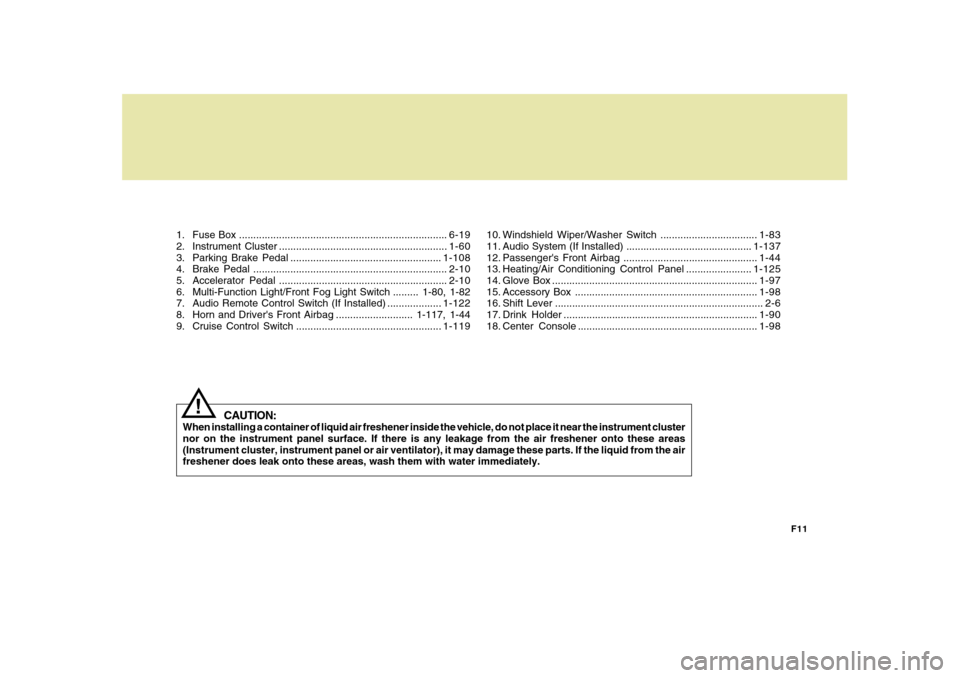
F11
1. Fuse Box .........................................................................6-19
2. Instrument Cluster ...........................................................1-60
3. Parking Brake Pedal .....................................................1-108
4. Brake Pedal ....................................................................2-10
5. Accelerator Pedal ...........................................................2-10
6. Multi-Function Light/Front Fog Light Switch ......... 1-80, 1-82
7. Audio Remote Control Switch (If Installed) ...................1-122
8. Horn and Driver's Front Airbag ........................... 1-117, 1-44
9. Cruise Control Switch ...................................................1-119
CAUTION:
When installing a container of liquid air freshener inside the vehicle, do not place it near the instrument cluster
nor on the instrument panel surface. If there is any leakage from the air freshener onto these areas
(Instrument cluster, instrument panel or air ventilator), it may damage these parts. If the liquid from the air
freshener does leak onto these areas, wash them with water immediately.
!
10. Windshield Wiper/Washer Switch ..................................1-83
11. Audio System (If Installed) ............................................1-137
12. Passenger's Front Airbag ...............................................1-44
13. Heating/Air Conditioning Control Panel .......................1-125
14. Glove Box ........................................................................1-97
15. Accessory Box ................................................................1-98
16. Shift Lever ......................................................................... 2-6
17. Drink Holder ....................................................................1-90
18. Center Console ...............................................................1-98
Page 17 of 345
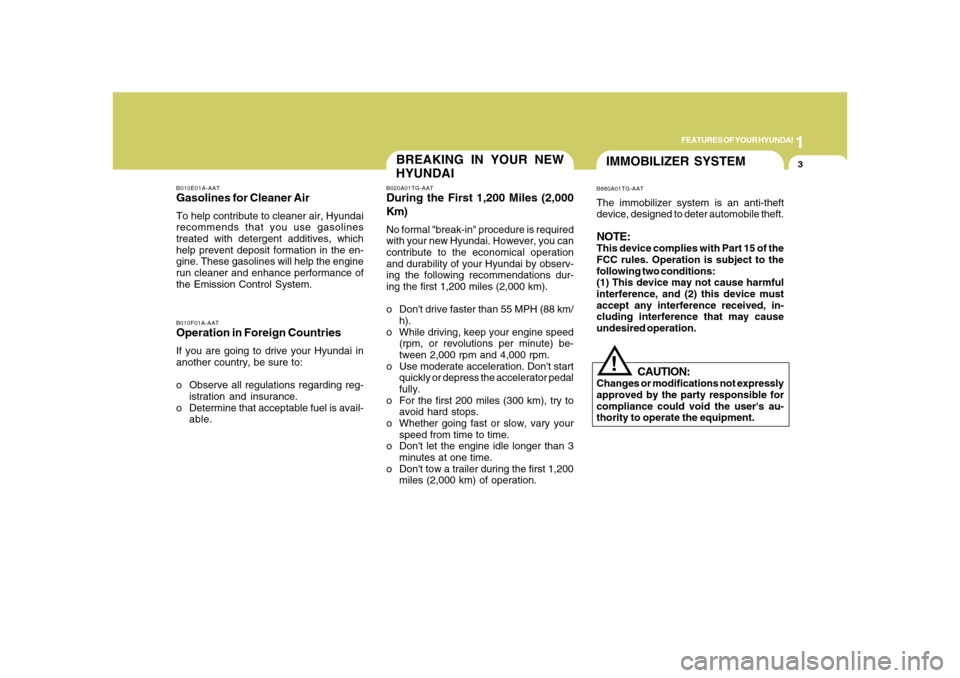
1
FEATURES OF YOUR HYUNDAI
3
BREAKING IN YOUR NEW
HYUNDAI
B010F01A-AATOperation in Foreign CountriesIf you are going to drive your Hyundai in
another country, be sure to:
o Observe all regulations regarding reg-
istration and insurance.
o Determine that acceptable fuel is avail-
able.B010E01A-AATGasolines for Cleaner AirTo help contribute to cleaner air, Hyundai
recommends that you use gasolines
treated with detergent additives, which
help prevent deposit formation in the en-
gine. These gasolines will help the engine
run cleaner and enhance performance of
the Emission Control System.
B020A01TG-AATDuring the First 1,200 Miles (2,000
Km)No formal "break-in" procedure is required
with your new Hyundai. However, you can
contribute to the economical operation
and durability of your Hyundai by observ-
ing the following recommendations dur-
ing the first 1,200 miles (2,000 km).
o Don't drive faster than 55 MPH (88 km/
h).
o While driving, keep your engine speed
(rpm, or revolutions per minute) be-
tween 2,000 rpm and 4,000 rpm.
o Use moderate acceleration. Don't start
quickly or depress the accelerator pedal
fully.
o For the first 200 miles (300 km), try to
avoid hard stops.
o Whether going fast or slow, vary your
speed from time to time.
o Don't let the engine idle longer than 3
minutes at one time.
o Don't tow a trailer during the first 1,200
miles (2,000 km) of operation.
IMMOBILIZER SYSTEMB880A01TG-AATThe immobilizer system is an anti-theft
device, designed to deter automobile theft.NOTE:This device complies with Part 15 of the
FCC rules. Operation is subject to the
following two conditions:
(1) This device may not cause harmful
interference, and (2) this device must
accept any interference received, in-
cluding interference that may cause
undesired operation.
CAUTION:
Changes or modifications not expressly
approved by the party responsible for
compliance could void the user's au-
thority to operate the equipment.
!
Page 55 of 345
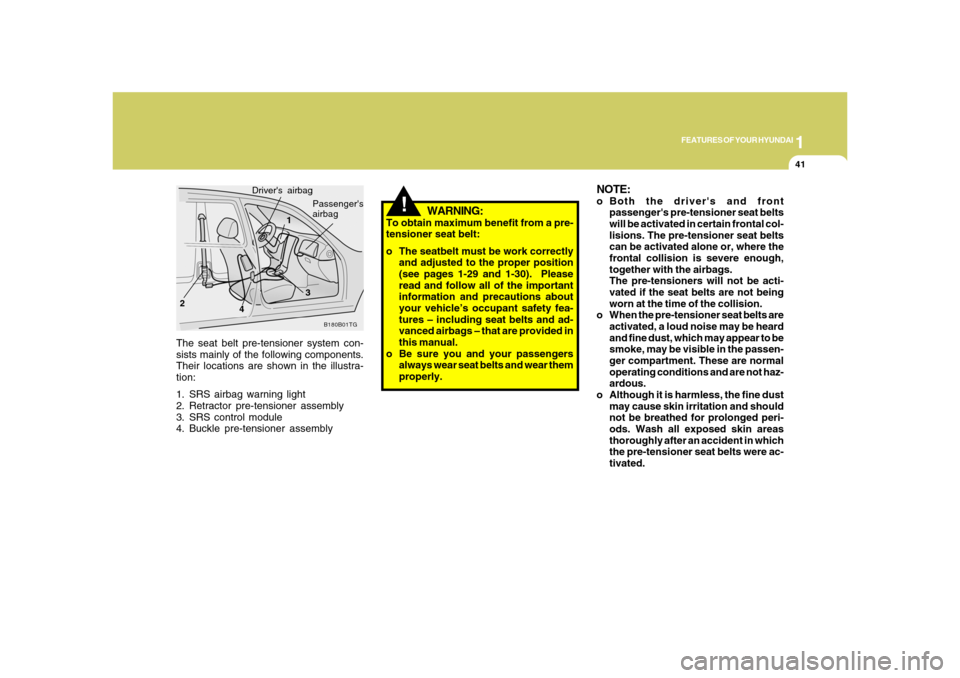
1
FEATURES OF YOUR HYUNDAI
41
!
The seat belt pre-tensioner system con-
sists mainly of the following components.
Their locations are shown in the illustra-
tion:
1. SRS airbag warning light
2. Retractor pre-tensioner assembly
3. SRS control module
4. Buckle pre-tensioner assembly
B180B01TG
1
23 Driver's airbag
Passenger's
airbag
WARNING:
To obtain maximum benefit from a pre-
tensioner seat belt:
o The seatbelt must be work correctly
and adjusted to the proper position
(see pages 1-29 and 1-30). Please
read and follow all of the important
information and precautions about
your vehicle’s occupant safety fea-
tures – including seat belts and ad-
vanced airbags – that are provided in
this manual.
o Be sure you and your passengers
always wear seat belts and wear them
properly.
4
NOTE:o Both the driver's and front
passenger's pre-tensioner seat belts
will be activated in certain frontal col-
lisions. The pre-tensioner seat belts
can be activated alone or, where the
frontal collision is severe enough,
together with the airbags.
The pre-tensioners will not be acti-
vated if the seat belts are not being
worn at the time of the collision.
o When the pre-tensioner seat belts are
activated, a loud noise may be heard
and fine dust, which may appear to be
smoke, may be visible in the passen-
ger compartment. These are normal
operating conditions and are not haz-
ardous.
o Although it is harmless, the fine dust
may cause skin irritation and should
not be breathed for prolonged peri-
ods. Wash all exposed skin areas
thoroughly after an accident in which
the pre-tensioner seat belts were ac-
tivated.
Page 58 of 345
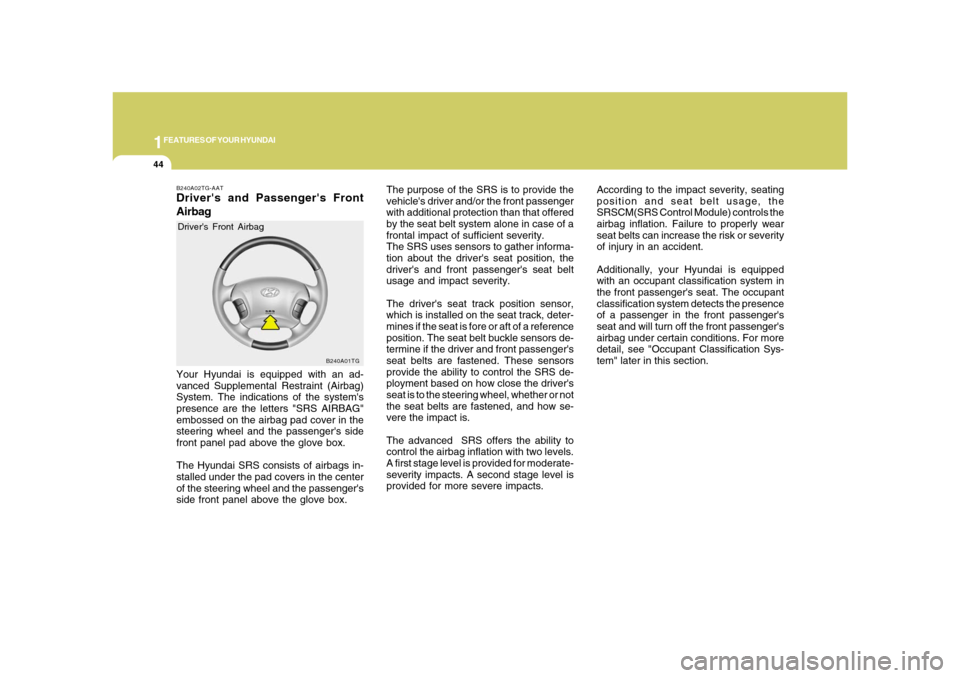
1FEATURES OF YOUR HYUNDAI44
B240A01TG
The purpose of the SRS is to provide the
vehicle's driver and/or the front passenger
with additional protection than that offered
by the seat belt system alone in case of a
frontal impact of sufficient severity.
The SRS uses sensors to gather informa-
tion about the driver's seat position, the
driver's and front passenger's seat belt
usage and impact severity.
The driver's seat track position sensor,
which is installed on the seat track, deter-
mines if the seat is fore or aft of a reference
position. The seat belt buckle sensors de-
termine if the driver and front passenger's
seat belts are fastened. These sensors
provide the ability to control the SRS de-
ployment based on how close the driver's
seat is to the steering wheel, whether or not
the seat belts are fastened, and how se-
vere the impact is.
The advanced SRS offers the ability to
control the airbag inflation with two levels.
A first stage level is provided for moderate-
severity impacts. A second stage level is
provided for more severe impacts.According to the impact severity, seating
position and seat belt usage, the
SRSCM(SRS Control Module) controls the
airbag inflation. Failure to properly wear
seat belts can increase the risk or severity
of injury in an accident.
Additionally, your Hyundai is equipped
with an occupant classification system in
the front passenger's seat. The occupant
classification system detects the presence
of a passenger in the front passenger's
seat and will turn off the front passenger's
airbag under certain conditions. For more
detail, see "Occupant Classification Sys-
tem" later in this section.
B240A02TG-AATDriver's and Passenger's Front
AirbagYour Hyundai is equipped with an ad-
vanced Supplemental Restraint (Airbag)
System. The indications of the system's
presence are the letters "SRS AIRBAG"
embossed on the airbag pad cover in the
steering wheel and the passenger's side
front panel pad above the glove box.
The Hyundai SRS consists of airbags in-
stalled under the pad covers in the center
of the steering wheel and the passenger's
side front panel above the glove box.Driver's Front Airbag
Page 66 of 345
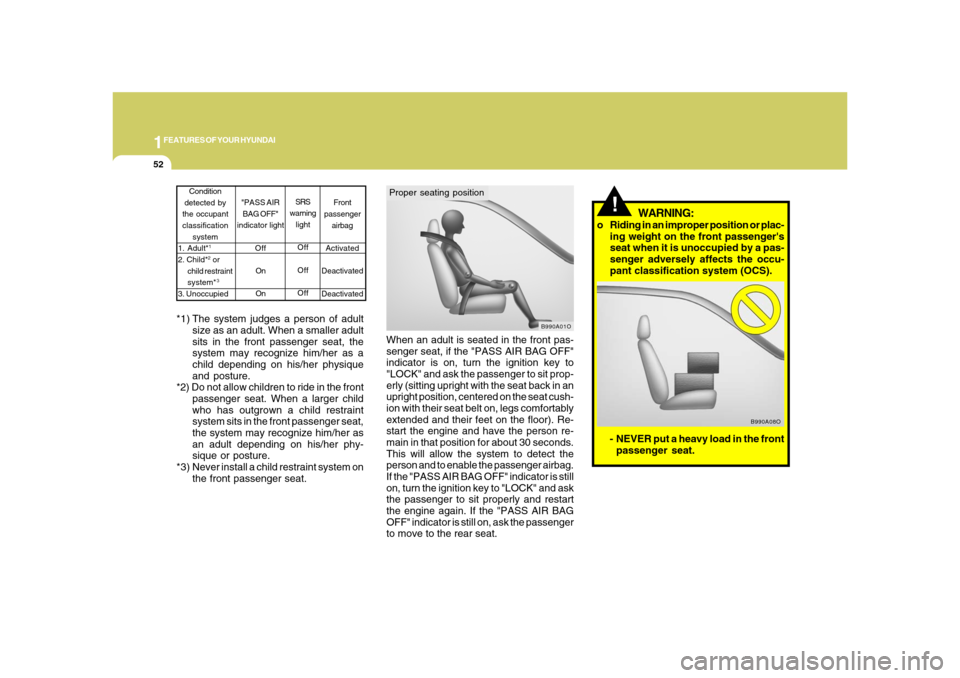
1FEATURES OF YOUR HYUNDAI52
- NEVER put a heavy load in the front
passenger seat.
B990A08O
!
WARNING:
o Riding in an improper position or plac-
ing weight on the front passenger's
seat when it is unoccupied by a pas-
senger adversely affects the occu-
pant classification system (OCS).
*1) The system judges a person of adult
size as an adult. When a smaller adult
sits in the front passenger seat, the
system may recognize him/her as a
child depending on his/her physique
and posture.
*2) Do not allow children to ride in the front
passenger seat. When a larger child
who has outgrown a child restraint
system sits in the front passenger seat,
the system may recognize him/her as
an adult depending on his/her phy-
sique or posture.
*3) Never install a child restraint system on
the front passenger seat.
Front
passenger
airbag
Activated
Deactivated
Deactivated Condition
detected by
the occupant
classification
system
1. Adult*
1
2. Child*
2 or
child restraint
system*3
3. UnoccupiedSRS
warning
light
Off
Off
Off "PASS AIR
BAG OFF"
indicator light
Off
On
On
When an adult is seated in the front pas-
senger seat, if the "PASS AIR BAG OFF"
indicator is on, turn the ignition key to
"LOCK" and ask the passenger to sit prop-
erly (sitting upright with the seat back in an
upright position, centered on the seat cush-
ion with their seat belt on, legs comfortably
extended and their feet on the floor). Re-
start the engine and have the person re-
main in that position for about 30 seconds.
This will allow the system to detect the
person and to enable the passenger airbag.
If the "PASS AIR BAG OFF" indicator is still
on, turn the ignition key to "LOCK" and ask
the passenger to sit properly and restart
the engine again. If the "PASS AIR BAG
OFF" indicator is still on, ask the passenger
to move to the rear seat.Proper seating position
B990A01O
Page 67 of 345
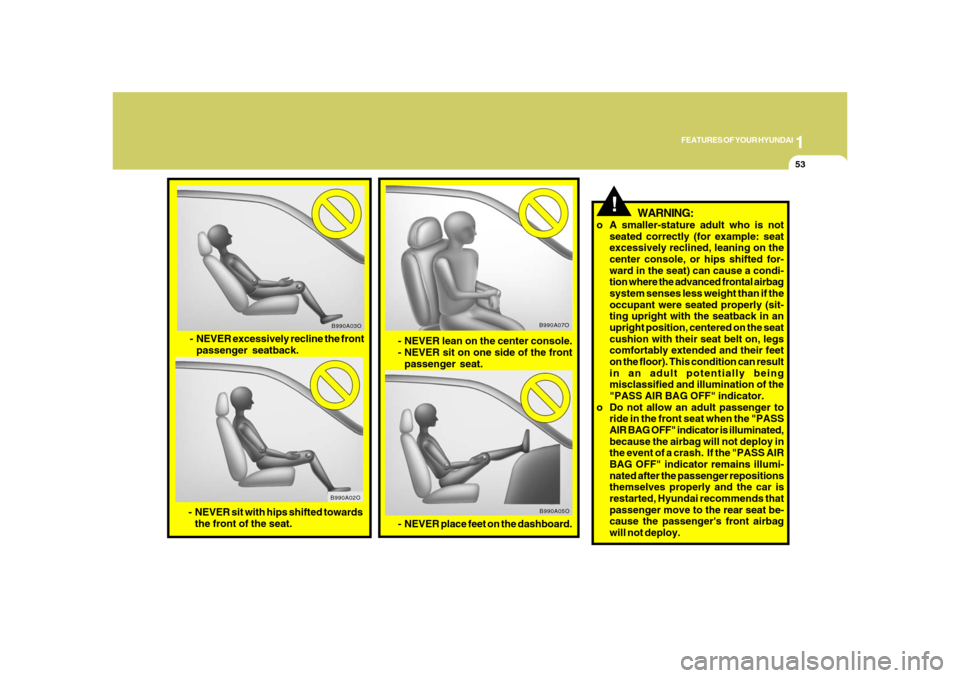
1
FEATURES OF YOUR HYUNDAI
53
- NEVER lean on the center console.
- NEVER sit on one side of the front
passenger seat.
B990A07O
B990A05O
- NEVER place feet on the dashboard.
- NEVER excessively recline the front
passenger seatback.
- NEVER sit with hips shifted towards
the front of the seat.
B990A03O
B990A02O
!
WARNING:
o A smaller-stature adult who is not
seated correctly (for example: seat
excessively reclined, leaning on the
center console, or hips shifted for-
ward in the seat) can cause a condi-
tion where the advanced frontal airbag
system senses less weight than if the
occupant were seated properly (sit-
ting upright with the seatback in an
upright position, centered on the seat
cushion with their seat belt on, legs
comfortably extended and their feet
on the floor). This condition can result
in an adult potentially being
misclassified and illumination of the
"PASS AIR BAG OFF" indicator.
o Do not allow an adult passenger to
ride in the front seat when the "PASS
AIR BAG OFF" indicator is illuminated,
because the airbag will not deploy in
the event of a crash. If the "PASS AIR
BAG OFF" indicator remains illumi-
nated after the passenger repositions
themselves properly and the car is
restarted, Hyundai recommends that
passenger move to the rear seat be-
cause the passenger's front airbag
will not deploy.
Page 70 of 345
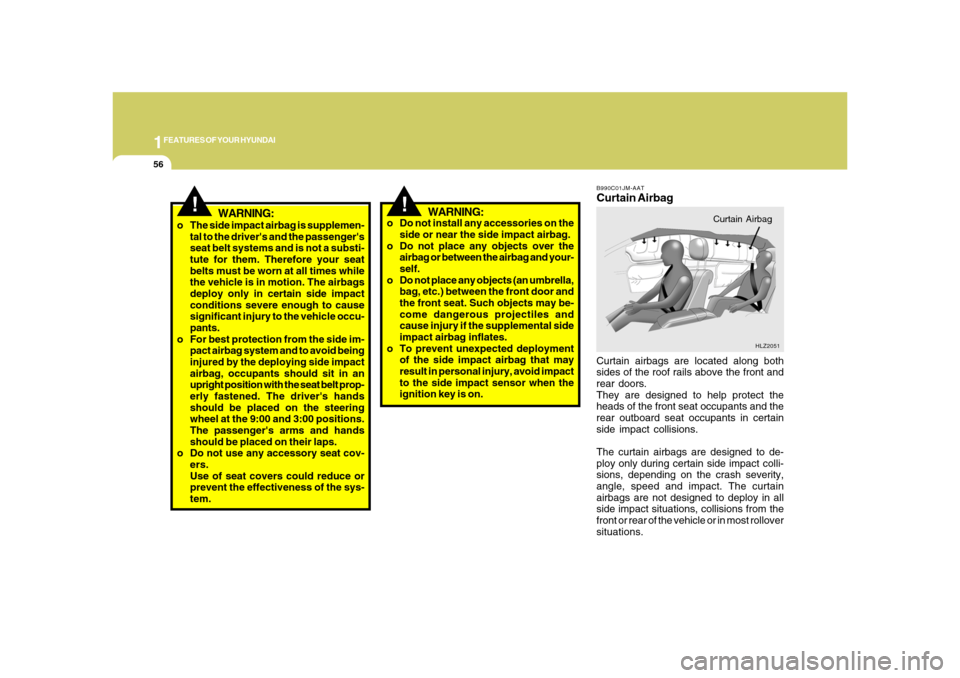
1FEATURES OF YOUR HYUNDAI56
!
o Do not install any accessories on the
side or near the side impact airbag.
o Do not place any objects over the
airbag or between the airbag and your-
self.
o Do not place any objects (an umbrella,
bag, etc.) between the front door and
the front seat. Such objects may be-
come dangerous projectiles and
cause injury if the supplemental side
impact airbag inflates.
o To prevent unexpected deployment
of the side impact airbag that may
result in personal injury, avoid impact
to the side impact sensor when the
ignition key is on.
WARNING:
B990C01JM-AATCurtain AirbagCurtain airbags are located along both
sides of the roof rails above the front and
rear doors.
They are designed to help protect the
heads of the front seat occupants and the
rear outboard seat occupants in certain
side impact collisions.
The curtain airbags are designed to de-
ploy only during certain side impact colli-
sions, depending on the crash severity,
angle, speed and impact. The curtain
airbags are not designed to deploy in all
side impact situations, collisions from the
front or rear of the vehicle or in most rollover
situations.
HLZ2051
Curtain Airbag
WARNING:
o The side impact airbag is supplemen-
tal to the driver's and the passenger's
seat belt systems and is not a substi-
tute for them. Therefore your seat
belts must be worn at all times while
the vehicle is in motion. The airbags
deploy only in certain side impact
conditions severe enough to cause
significant injury to the vehicle occu-
pants.
o For best protection from the side im-
pact airbag system and to avoid being
injured by the deploying side impact
airbag, occupants should sit in an
upright position with the seat belt prop-
erly fastened. The driver's hands
should be placed on the steering
wheel at the 9:00 and 3:00 positions.
The passenger's arms and hands
should be placed on their laps.
o Do not use any accessory seat cov-
ers.
Use of seat covers could reduce or
prevent the effectiveness of the sys-
tem.
!
Page 118 of 345
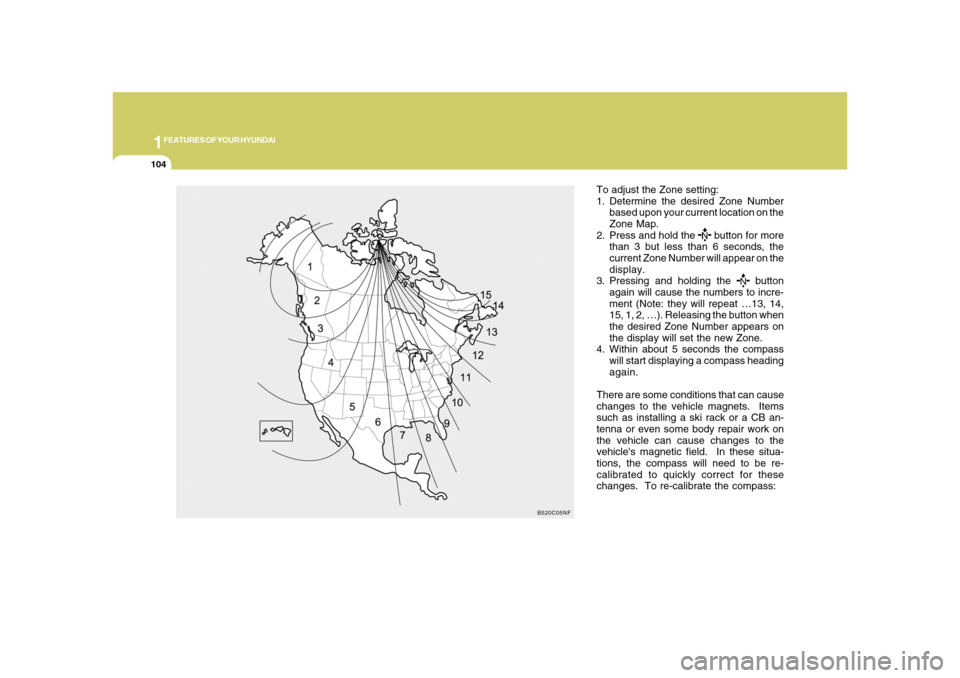
1FEATURES OF YOUR HYUNDAI
104
To adjust the Zone setting:
1. Determine the desired Zone Number
based upon your current location on the
Zone Map.
2. Press and hold the
button for more
than 3 but less than 6 seconds, the
current Zone Number will appear on the
display.
3. Pressing and holding the
button
again will cause the numbers to incre-
ment (Note: they will repeat …13, 14,
15, 1, 2, …). Releasing the button when
the desired Zone Number appears on
the display will set the new Zone.
4. Within about 5 seconds the compass
will start displaying a compass heading
again.
There are some conditions that can cause
changes to the vehicle magnets. Items
such as installing a ski rack or a CB an-
tenna or even some body repair work on
the vehicle can cause changes to the
vehicle's magnetic field. In these situa-
tions, the compass will need to be re-
calibrated to quickly correct for these
changes. To re-calibrate the compass:
B520C05NF
Page 139 of 345
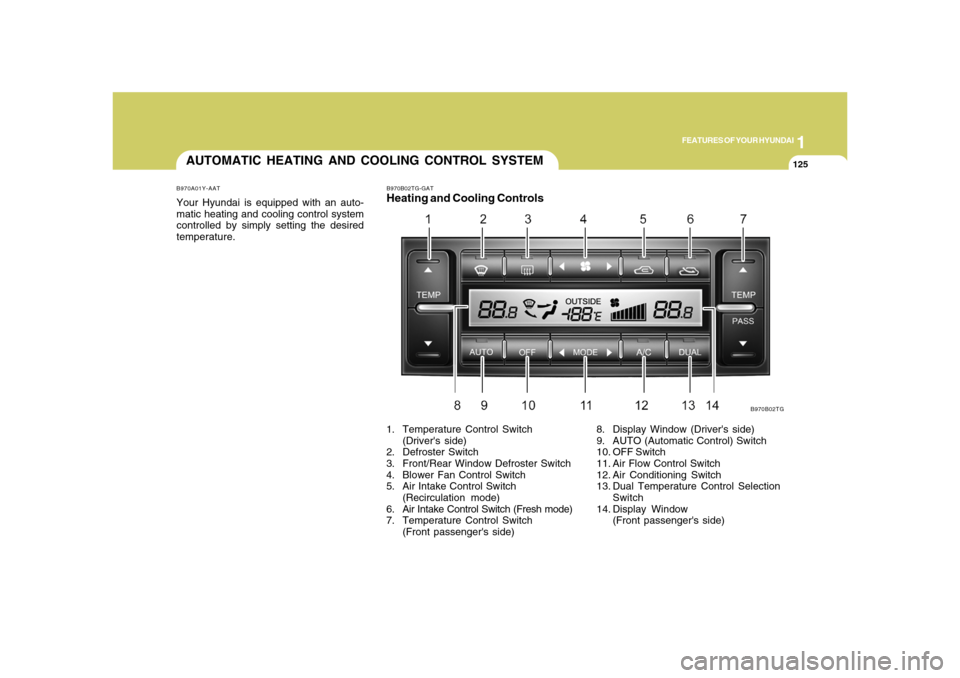
1
FEATURES OF YOUR HYUNDAI
125125
AUTOMATIC HEATING AND COOLING CONTROL SYSTEMB970A01Y-AATYour Hyundai is equipped with an auto-
matic heating and cooling control system
controlled by simply setting the desired
temperature.
B970B02TG-GATHeating and Cooling Controls1. Temperature Control Switch
(Driver's side)
2. Defroster Switch
3. Front/Rear Window Defroster Switch
4. Blower Fan Control Switch
5. Air Intake Control Switch
(Recirculation mode)
6. Air Intake Control Switch (Fresh mode)
7. Temperature Control Switch
(Front passenger's side)
B970B02TG
8. Display Window (Driver's side)
9. AUTO (Automatic Control) Switch
10. OFF Switch
11. Air Flow Control Switch
12. Air Conditioning Switch
13. Dual Temperature Control Selection
Switch
14. Display Window
(Front passenger's side)